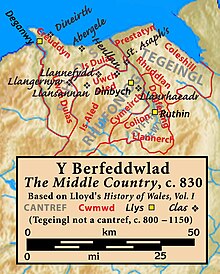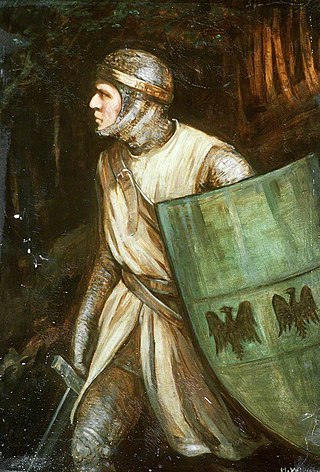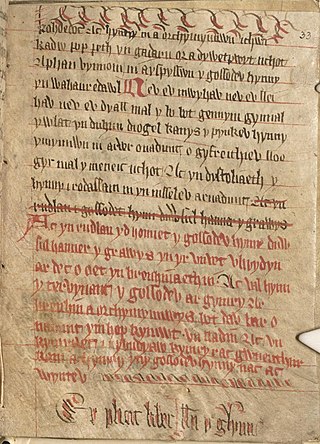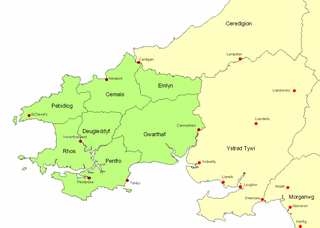
Tegeingl, also known as Englefield, [1] was a cantref in north-east Wales during the mediaeval period. It was incorporated into Flintshire following Edward I of England's conquest of northern Wales in the 13th century.

Tegeingl, also known as Englefield, [1] was a cantref in north-east Wales during the mediaeval period. It was incorporated into Flintshire following Edward I of England's conquest of northern Wales in the 13th century.
The region's name was derived from the Deceangli , an Iron Age Celtic tribe which had inhabited the region and attested since the 1st century BC.
The cantref formed the eastern part of Perfeddwlad (or Y Berfeddwlad) on the northern coast of Wales between the River Clwyd and Deeside. The territory is roughly equivalent to the modern county of Flintshire today.
Comprising the three commotes of Rhuddlan, Prestatyn and Coleshill (Cwnsyllt), [2] the territory originally formed part of the Kingdom of Gwynedd until, in the late 8th century, it was conquered by the Anglo-Saxon Kingdom of Mercia. It remained under Mercian (or English) control for over three centuries until Dafydd ab Owain Gwynedd recovered it in the 12th century. [2] Edwin of Tegeingl (d.1073) was in the 11th century described as "lord" or "prince" of Tegeingl. [2] He was succeeded as lord of Tegeingl by his son Owain who supported the Anglo-Normans' invasion of North Wales in the 1090s. [3] The family remained powerful in North Wales until Owain's sons were killed in 1125 by a son of Gruffudd ap Cynan, Prince of Gwynedd. [4]
It then changed hands several times between England and Gwynedd, [5] but was eventually seized by Edward I as part of his conquest of the Principality of Wales between 1277 and 1283. It was then incorporated into the county of Flintshire by the Statute of Rhuddlan. [6]

Owain ap Gruffudd was King of Gwynedd, North Wales, from 1137 until his death in 1170, succeeding his father Gruffudd ap Cynan. He was called Owain the Great and the first to be styled "Prince of Wales", and the "Prince of the Welsh". He is considered to be the most successful of all the North Welsh princes prior to his grandson, Llywelyn the Great. He became known as Owain Gwynedd to distinguish him from the contemporary king of Powys Wenwynwyn, Owain ap Gruffydd ap Maredudd, who became known as Owain Cyfeiliog.

Gruffudd ap Cynan, sometimes written as Gruffydd ap Cynan, was King of Gwynedd from 1081 until his death in 1137. In the course of a long and eventful life, he became a key figure in Welsh resistance to Norman rule.

Deheubarth was a regional name for the realms of south Wales, particularly as opposed to Gwynedd. It is now used as a shorthand for the various realms united under the House of Dinefwr, but that Deheubarth itself was not considered a proper kingdom on the model of Gwynedd, Powys, or Dyfed is shown by its rendering in Latin as dextralis pars or as Britonnes dexterales and not as a named land. In the oldest British writers, Deheubarth was used for all of modern Wales to distinguish it from Hen Ogledd, the northern lands whence Cunedda originated.

The Statute of Rhuddlan, also known as the Statutes of Wales or as the Statute of Wales, was a royal ordinance by Edward I of England, which gave the constitutional basis for the government of the Principality of Wales from 1284 until 1536.

The Kingdom of Gwynedd was a Welsh kingdom and a Roman Empire successor state that emerged in sub-Roman Britain in the 5th century during the Anglo-Saxon settlement of Britain.

Rhuddlan is a town, community, and electoral ward in the county of Denbighshire, Wales, in the historic county of Flintshire. Its associated urban zone is mainly on the right bank of the Clwyd; it is directly south of seafront town Rhyl. It gave its name to the Welsh district of Rhuddlan from 1974 to 1996. As of the 2001 census, the population was 4,296 decreasing to 3,709 in the 2011 census.

The Kingdom of Powys was a Welsh successor state, petty kingdom and principality that emerged during the Middle Ages following the end of Roman rule in Britain. It very roughly covered the northern two-thirds of the modern county of Powys and part of today's English West Midlands. More precisely, and based on the Romano-British tribal lands of the Ordovices in the west and the Cornovii in the east, its boundaries originally extended from the Cambrian Mountains in the west to include the modern West Midlands region of England in the east. The fertile river valleys of the Severn and Tern are found here, and this region is referred to in later Welsh literature as "the Paradise of Powys".

The Principality of Wales was originally the territory of the native Welsh princes of the House of Aberffraw from 1216 to 1283, encompassing two-thirds of modern Wales during its height of 1267–1277. Following the conquest of Wales by Edward I of England of 1277 to 1283, those parts of Wales retained under the direct control of the English crown, principally in the north and west of the country, were re-constituted as a new Principality of Wales and ruled either by the monarch or the monarch's heir though not formally incorporated into the Kingdom of England. This was ultimately accomplished with the Laws in Wales Acts 1535–1542 when the Principality ceased to exist as a separate entity.
Hywel ab Owain Gwynedd, Prince of Gwynedd in 1170, was a Welsh poet and military leader. Hywel was the son of Owain Gwynedd, prince of Gwynedd, and an Irishwoman named Pyfog. In recognition of this, he was also known as Hywel ap Gwyddeles. Hywel is also known as the Poet Prince for his bardic skills.

Bleddyn ap Cynfyn, sometimes spelled Blethyn, was an 11th-century Welsh king. King Harold Godwinson and Tostig Godwinson installed him and his brother, Rhiwallon, as the co-rulers of Gwynedd on his father's death in 1063, during their destruction of the kingdom of their half-brother, king Gruffydd ap Llywelyn. Bleddyn became king of Powys and co-ruler of the Kingdom of Gwynedd with his brother Rhiwallon from 1063 to 1075. His descendants continued to rule Powys as the House of Mathrafal.
Perfeddwlad or Y Berfeddwlad was an historic name for the territories in Wales lying between the River Conwy and the River Dee. comprising the cantrefi of Rhos, Rhufoniog, Dyffryn Clwyd and Tegeingl. Perfeddwlad thus was also known as the Four Cantrefs.

The Kingdom of Dyfed, one of several Welsh petty kingdoms that emerged in 5th-century sub-Roman Britain in southwest Wales, was based on the former territory of the Demetae. The medieval Irish narrative, The Expulsion of the Déisi, attributing the kingdom's founding to Eochaid, son of Artchorp, being forced across the Irish sea, in the 5th century; his descendants founding the line of the kings of Dyfed, down to "Tualodor mac Rígin". The Normans invaded Wales, and by 1138 incorporated Dyfed into a new shire called Pembrokeshire after the Norman castle built in the Cantref of Penfro and under the rule of the Marcher Earl of Pembroke.
This article is about the particular significance of the century 1001–1100 to Wales and its people.

The history of Gwynedd in the High Middle Ages is a period in the History of Wales spanning the 11th through the 13th centuries. Gwynedd, located in the north of Wales, eventually became the most dominant of Welsh polities during this period. Contact with continental courts allowed for Gwynedd to transition from a petty kingdom into an increasingly sophisticated principality of seasoned courtiers capable of high level deplomacy and representation; not only with the Angevine kings, but also the king of France and the Papal See. Distinctive achievements in Gwynedd include further development of Medieval Welsh literature, particularly poets known as the Beirdd y Tywysogion associated with the court of Gwynedd; the reformation of bardic schools; and the continued development of Cyfraith Hywel. All three of these further contributed to the development of a Welsh national identity in the face of Anglo-Norman encroachment of Wales.

The House of Aberffraw was a medieval royal court based in the village it was named after, Aberffraw, Anglesey within the borders of the then Kingdom of Gwynedd. The dynasty was founded in the 9th century by a King in Wales whose descendants founded the Welsh Royal Houses. The other medieval Welsh dynasties were the Royal Houses of Dinefwr, Mathrafal.

The Royal House of Mathrafal began as a cadet branch of the Welsh Royal House of Dinefwr, taking their name from Mathrafal Castle. They effectively replaced the House of Gwertherion, who had been ruling the Kingdom of Powys since late Roman Britain, through the politically advantageous marriage of an ancestor, Merfyn the Oppressor. King Bleddyn ap Cynfyn would join the resistance of the Anglo-Saxon King Harold Godwinson, against the invasion of William the Conqueror, following the Norman conquest of England. Thereafter, they would struggle with the Plantagenets and the remaining Welsh Royal houses for the control of Wales. Although their fortunes rose and fell over the generations, they are primarily remembered as Kings of Powys and last native Prince of Wales.
Edwin of Tegeingl was a prince or lord of the cantref of Tegeingl in north-east Wales.
Owain ab Edwin of Tegeingl or Owain the Traitor, was lord of the cantref of Tegeingl in north-east Wales at the end of the 11th century. He was the son of Edwin ap Gronw of Tegeingl, a great-great-grandson of Hywel Dda. He sided with the Normans in their failed invasion of North Wales, and in the 1090s attempted to become ruler of Gwynedd.

The conquest of Wales by Edward I took place between 1277 and 1283. It is sometimes referred to as the Edwardian conquest of Wales, to distinguish it from the earlier Norman conquest of Wales. In two campaigns, in 1277 and 1282–83, respectively, Edward I of England first greatly reduced the territory of Llywelyn ap Gruffudd, and then completely overran it, as well as the other remaining Welsh principalities.